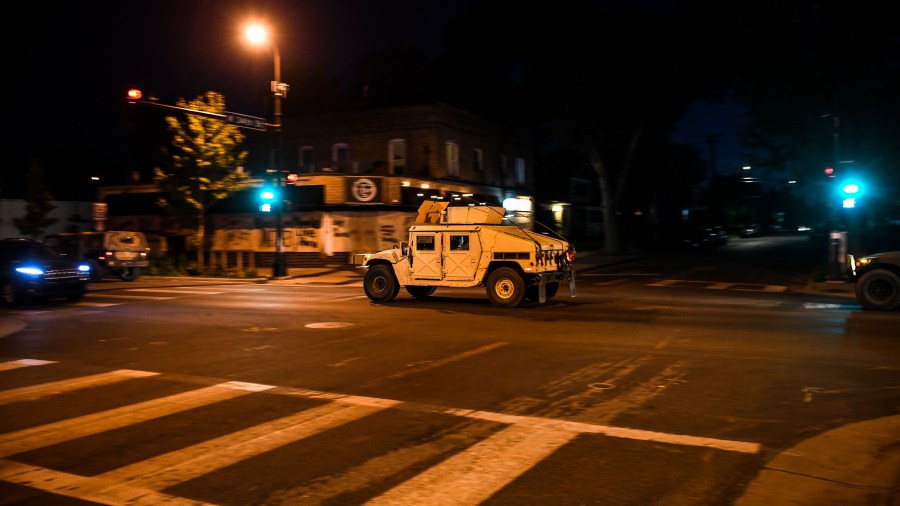Police can track protesters even after the demonstrations end

It’s too soon to know what surveillance tools police departments across the country have been using to identify protesters and looters in the past week. But we know there are a lot of them, from widespread camera technology and license plate readers to drones. Not to mention the facial-recognition tool known as Clearview AI, which has been used by dozens, if not hundreds, of law enforcement agencies.
Civil rights activists say these tools can be used to track protests, in some cases to keep the peace, but they can also be used to find organizers and even arrest protesters after the fact. There aren’t a lot of rules about how they get used. I spoke with Saira Hussain, a lawyer for the Electronic Frontier Foundation. The following is an edited transcript of our conversation.

Saira Hussain: Law enforcement has access to things like CCTV networks, gunshot detection, stingrays (more commonly known as cell site simulators), face recognition, possible aerial surveillance. Oftentimes, law enforcement also has the ability to access private networks like Ring. Law enforcement agencies many times are acquiring these technologies without any sort of public process where the public may not even be aware that they’re using it. And because courts haven’t necessarily caught up to the use of these various technologies, oftentimes the constitutional protections aren’t put in place either.
Molly Wood: We’ve heard a lot of reporting about Clearview AI specifically. How much, to your knowledge, is that in use now?
Hussain: When we’re talking about face recognition, we know that it is proliferating across the country, that there are many law enforcement agencies that already have this in use. We know that after the whole Clearview scandal came to light, that some law enforcement agencies decided to stop their partnership, but others haven’t. Clearview is the subject of active litigation [and] some law enforcement agencies continue to partner with them.
Wood: In the context of protest, how are these tools used before, during and after?
Hussain: In the moment, there are technologies being used. Things like cell site simulators as well, that can then identify where the locations of these devices are. Individuals who posted on Facebook or Twitter were identified after the fact. Baltimore is one of the most prevalent examples that we have seen where we actually know that law enforcement used this tool called Geofeedia, which looked at public feeds for social media to try to identify people’s locations during the 2015 protests in Baltimore to protest the death of Freddie Gray. Many people were arrested on completely unrelated charges because they were in the vicinity of the protests. Mass surveillance in that form is incredibly problematic, but also knowing that when we’re talking about face recognition, they can always look at the footage after the fact and connect you through the readers that they have with the face recognition. I think that it’s really important for people to know that we’re not just talking about in the moment, but also after the fact that this technology can possibly be used by law enforcement.

Related links: More insight from Molly Wood
There’s some reading on the Clearview AI lawsuit. A lawyer for the ACLU told The New York Times that the company’s technology, if left unchecked, is “going to end privacy as we know it.” And Wired has a piece called “How to Protest Safely in the Age of Surveillance.”
Also watching:
A virtual protest at Facebook occurred over the company’s refusal to flag or remove the inflammatory post by President Donald Trump that invoked shooting protesters, using a phrase from the ’60s associated with racial violence and aggressive policing. Employees posted publicly on Twitter to say they disagreed with Facebook’s stance and CEO Mark Zuckerberg’s reasoning and staged what some call a virtual walkout. Two senior executives told The New York Times they would resign if the decision was not reversed, and another reportedly decided not to start a new job at the company. Other employees are circulating petitions internally. Zuckerberg is scheduled to take questions from employees in a company town hall Tuesday.
As for another tech billionaire who runs a social media site, The Information got its hands on a 2,000-word internal memo from Snap CEO Evan Spiegel, a guy who doesn’t usually say much but wrote to employees that racial and economic inequality means that the “American experiment is failing.” He said the U.S. needs a commission on racism and its legacy to strengthen civil rights, investigate the criminal-justice system and make reparations to America’s black community. The 29-year-old executive also wrote that billionaires and corporations must pay higher taxes to ensure a fairer society. It was, to say the least, unexpected.
The future of this podcast starts with you.
Every day, the “Marketplace Tech” team demystifies the digital economy with stories that explore more than just Big Tech. We’re committed to covering topics that matter to you and the world around us, diving deep into how technology intersects with climate change, inequity, and disinformation.
As part of a nonprofit newsroom, we’re counting on listeners like you to keep this public service paywall-free and available to all.
Support “Marketplace Tech” in any amount today and become a partner in our mission.












